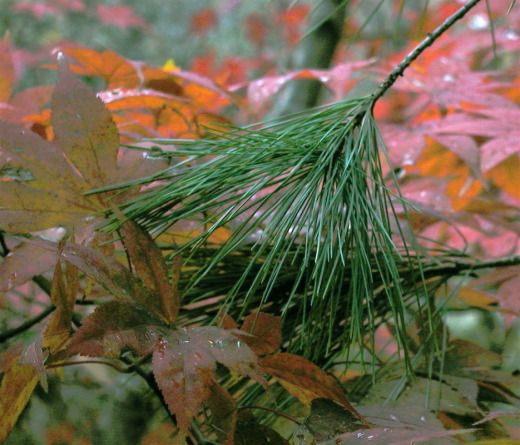Evergreens, the regents of winter
 Sunday, November 22, 2009 at 6:36PM
Sunday, November 22, 2009 at 6:36PM "This weather makes me want to curl up in in my pajamas and drink hot chocolate!"
We were standing outside a funeral home in a cold mist. A friend's father, age 97, had passed away. It was an uplifting service. This great-great grandfather had led a productive, interesting life. He was a good man who loved God. No doubt, right now the weather is much nicer where he is than where we are .
Winter's breath, damp and chilly, is coming over the land, giving me goosebumps which won't go away completely till next spring. I am always cold in the winter. Even inside the house I will wear a sweater or jacket. It is a good thing I live in Alabama, where winter is short and half-hearted. How do people in Canada survive?
However, there are some things I like about winter:
1. Hot chocolate
2. My sweet husband getting up early to build a fire in the fireplace and to prepare breakfast for me. (He has spoiled me rotten, I know.)
3. Evergreens
I love evergreens, those regents of winter which offer shelter and food to wildlife. Many are stately trees that stand guard against cold winds. All of them are beautiful and provide color and structure to the winter landscape.
Prior to the funeral today, I was out with my camera to capture some of these beauties before the rain started.
Osmanthus heterophyllus, also called holly tea olive, has wonderful variegated leaves.

Yaupon holly is another one of my favorites. It is native to our area. This is a dwarf variety which is commonly used for hedges and foundation plantings. People pretty much take them for granted, but they should stop and take a good look at their petite leaves. The latin name for yaupon is ilex vomitoris, which describes what happens if you ingest it.
Nandina domestica, or heavenly bamboo, has bright red berries to brighten drab winter days.
Today I found a nandina with white berries, which is unusual, but quite pretty, I think.
This weeping blue cedar is in the woodland garden. I have a fondness for all kinds of weeping trees. This is one of my favorites. It is slow growing. I think it has taken a decade for it to become four feet tall, though it is wider than that.
The Arizona cypress, despite its name, has grown well here. I love its color and its lacy needles.
The sculptural quality of branches is highlighted against the blue green color of a deodar cedar.

I had to take a photo of the bark of this longleaf pine. It is a huge tree near the border of my property.
And finally. below are autumn fern and spreading yew. Both give structure and fresh green color to the woodland garden throughout the year. Have a great week and Happy Thanksgiving to you all, Deborah
 evergreens,
evergreens,  regents of winter,
regents of winter,  woodland garden in
woodland garden in  plants,
plants,  woodland garden
woodland garden